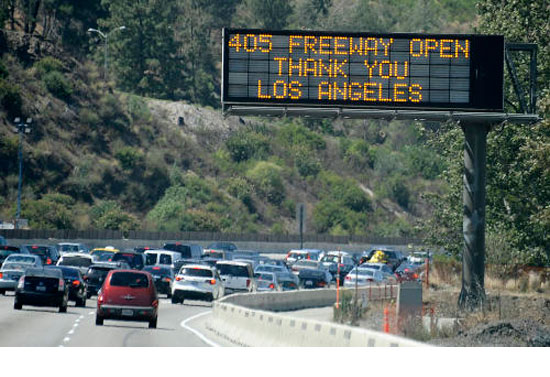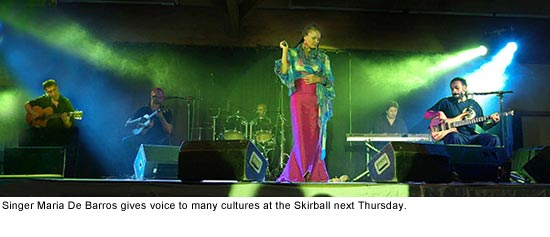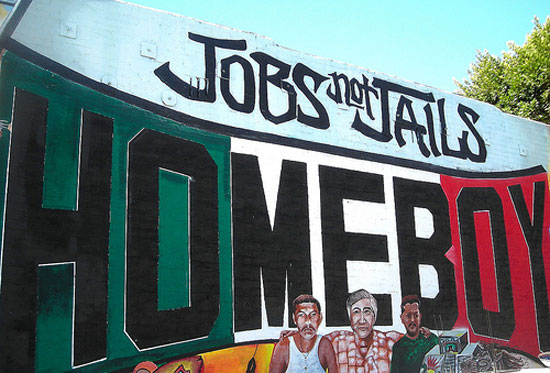Carmageddon by the numbers
July 19, 2011
So how big an impact did the 405 closure have on Los Angeles last weekend? Big, if you believe the statistics that have been trickling in this week. Some numbers—such as the sales tax receipts that will reflect the closure’s economic impact—won’t be available for a while yet. But it’s not too soon to begin a preliminary tally.
- Planned length of the closure: 53 hours. The actual length: 35 hours, 57 minutes on the southbound 405; 35 hours, 58 minutes on the northbound side.
- Amount of money Kiewit Infrastructure West could have been fined for finishing late on the demolition: $72,000 per hour. The bonus Kiewit got for finishing early: $300,000. Savings to the public in salary costs for the early finish (bonus included): $400,000.
- Approximate percentage of normal traffic Caltrans engineers expected would be diverted from the open stretches of the 405 during the closure: 20%. Actual amount: 64-65%.
- The number of vehicles on the northbound 405 at Culver on July 9, the Saturday before Carmageddon: 131,516. The number of vehicles on the northbound 405 at that same location on Carmageddon Saturday: 45,483.
- Estimated ridership increase on free Metro buses and subways: 15-20%.
- Travel time on the 101 Freeway from Laurel Canyon to Downtown L.A. on the Saturday before before the closure: 25 minutes. On Carmageddon Saturday: 12 minutes.
- Number of violent crimes reported to the Los Angeles County Sheriff’s Department and LAPD on Saturday, July 9: 276. On Carmageddon Saturday: 260.
- Number of traffic collisions handled by CHP countywide on July 9: 185. On Carmageddon Saturday: 136.
- Number of people arrested by CHP on Saturday for trying to walk or bicycle on the closed area of the 405: 8.
- Emergency room visits at Ronald Reagan UCLA Medical Center on Carmageddon Saturday: 94. Average daily number of emergency room visits at Ronald Reagan UCLA Medical Center: 121.
- Emergency room visits at Cedars-Sinai Medical Center on Carmageddon Saturday: 199. Average daily emergency room visits at Cedars-Sinai: 228.
- Number of 911 Fire/EMS calls to Los Angeles County and City Fire departments on July 9, the Saturday before Carmageddon: 2,037. Number of 911 Fire/EMS calls to Los Angeles County and City Fire departments on Carmageddon Saturday: 1,773.
- Ozone peak in Los Angeles County on Saturday, July 9, in parts per billion: 91. On Carmageddon Saturday 87.
- Attendance at Los Angeles County beaches on Saturday, July 9: 922,950. On Carmageddon Saturday: 544,850.
- Combined parking revenues from Will Rogers and Zuma beaches for the weekend before the 405 closure: $82,499. On Carmageddon weekend: $36,425—a drop of 55.8%.
- Expected turnout at the July 16 LA Galaxy-Real Madrid soccer game at the Los Angeles Memorial Coliseum: 60,000-100,000. Actual attendance: 56,211. Attendance at last year’s August match at the Rose Bowl between the same teams: 89,134.
- Some good news: Natural History Museum of Los Angeles County attendance on the Saturday before Carmageddon was 1,200. Attendance for the new Dinosaur Hall opening on Carmageddon Saturday: 3,785.
- Google search ranking for the term “Carmageddon” on July 15, the day before the closure: 3. Google search ranking on the same day for “Harry Potter reviews”: 5.
Sources: Los Angeles County Metropolitan Transportation Authority; Caltrans; Los Angeles County Sheriff’s Department; California Highway Patrol; Los Angeles County Dept. of Health Services Emergency Services Agency; South Coast Air Quality Management District; Los Angeles County Fire Department, Lifeguard Division; Los Angeles County Department of Beaches and Harbors; Los Angeles Coliseum; Will Rogers State Park; Natural History Museum of Los Angeles County; Los Angeles County Museum of Art; Google Trends
A speedy recovery on the 405
July 16, 2011
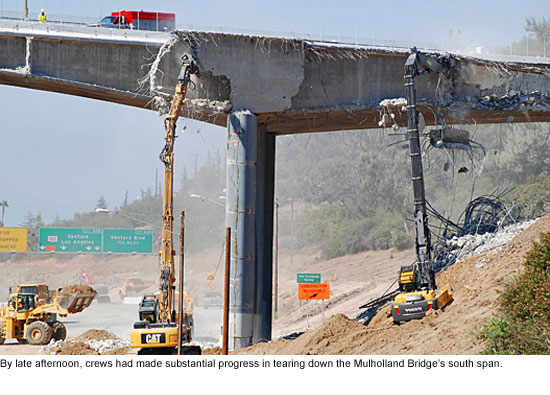 I’ve just spent the better part of this afternoon at the demolition site of the Mulholland Drive bridge over the 405 Freeway. I’m pleased to report (and I’m sure you’ll be pleased to know) that the work is ahead of schedule. The contractor, Kiewitt Co., has been doing a superb job. Its crews moved in last night, shortly after the freeway was closed, and began the demolition of the southern half of the bridge. Before sunset late this afternoon, the flanks of that part of the historic span were almost gone.
I’ve just spent the better part of this afternoon at the demolition site of the Mulholland Drive bridge over the 405 Freeway. I’m pleased to report (and I’m sure you’ll be pleased to know) that the work is ahead of schedule. The contractor, Kiewitt Co., has been doing a superb job. Its crews moved in last night, shortly after the freeway was closed, and began the demolition of the southern half of the bridge. Before sunset late this afternoon, the flanks of that part of the historic span were almost gone.
The consensus is that the contractor will beat by a considerable amount of time the 5:00 a.m. Monday deadline for the freeway’s reopening. Things can still go wrong; this is a complicated and difficult job. But the pace is promising. We’ll know more tonight or tomorrow morning.
Thanks again to all Southern California motorists who stepped up in the last 24 hours to make this freeway closure a far different kind of event than many of us had feared. Earlier today, as I viewed the region’s free-flowing traffic from a helicopter, I was awestruck by the clear evidence of the public’s vast cooperation. And for that little piece of “Carma-heaven” on our roads, we can all take pride.
Remember that we need to sustain this effort for just 24 to 36 more hours, until the job is done. Stay tuned to the news or to my website for the latest information on the progress of this project.
Posted 7/16/11
Could this be Carma-heaven?
July 16, 2011
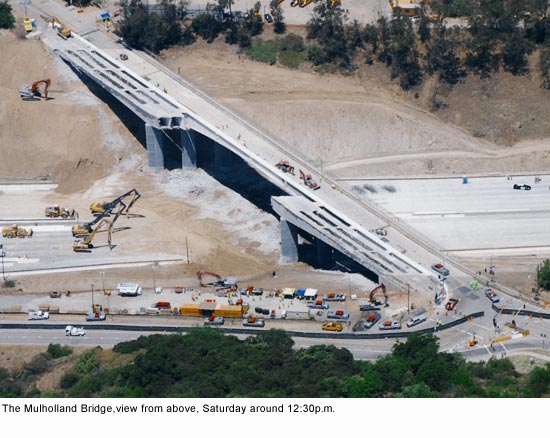 Thank you, Los Angeles, for successfully taking on Carmageddon. You stepped up yesterday evening and this morning. Southern California motorists followed the advice of public officials and traffic experts and are staying out of their cars. That is the only reason why traffic in our region was at all-time lows for a Friday evening.
Thank you, Los Angeles, for successfully taking on Carmageddon. You stepped up yesterday evening and this morning. Southern California motorists followed the advice of public officials and traffic experts and are staying out of their cars. That is the only reason why traffic in our region was at all-time lows for a Friday evening.
I was at the 405 and Mulholland Drive last night at midnight to witness the closing of the freeway and the beginning of the bridge removal project that has caused all of this fuss. It was an eerie feeling to see the cars thinning out on the freeway as the closing approached, but it was also heartening that this region came together in common cause to help manage what otherwise could have been a traffic nightmare.
As I told a reporter last night, most of us feel that if we don’t get in our car on a weekend and go somewhere, then somehow we’re being cheated. In fact, what L.A. is finding out this weekend is that there’s a lot to do and see within walking distance of our own homes.
We have 40 hours or less to go, and I urge all of you to stay the course. Stay home, patronize local stores and restaurants, and do everything you can to stay out of your cars until this weekend’s work is completed. It worked last night, and it’s working this morning. We need to sustain this for another day and a half, and then Carmageddon will be in our rear view mirror.
Posted 7/16/11
Zev discusses the 405 freeway closure
July 15, 2011

Zev discusses the July 16-17, 2011 405 Freeway closure.
This video was produced by the Jewish Journal.
Here we go
July 14, 2011
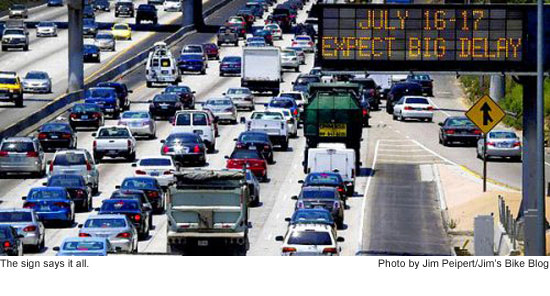 Yes, it’s finally here, “Carmageddon” weekend.
Yes, it’s finally here, “Carmageddon” weekend.
I feel confident that, by now, you know what I’m talking about. And that’s a testament to the extraordinary outreach efforts of our state and local transportation officials. Now, it’s up to us to help make sure that the 53-hour closure of the 405 Freeway isn’t any worse than it absolutely must be.
Of course, the best thing we can do is stay out of our cars for a couple days. But if you must hit the road, then please check the traffic reports and stay cool. There’s no need to see red (except for brake lights) if you leave early and are prepared for the frustrations of traffic. We’ve pulled together some basic information to help you on your way, which you’ll find here as part of our 405 Report. And if you’re looking for things to do—maybe 53 of them—check this out.
Meanwhile, I hope you’ll visit my website throughout the weekend. I’ll be blogging live, giving you my view of the unfolding events. I encourage you to upload photos of what you see out there to a special “Carmageddon” album we’ve created on the website’s “Picture This” feature.
I’ll also be posting updates on my Twitter and Facebook pages, so please drop by. No doubt, this will be a memorable weekend in L.A.’s traffic history. Let’s do our best—together—to make those memories good ones. Thanks for reading and, as always, you can reach me at [email protected].
Posted 7/14/11
Metro’s orange brigade hits the rails
July 13, 2011
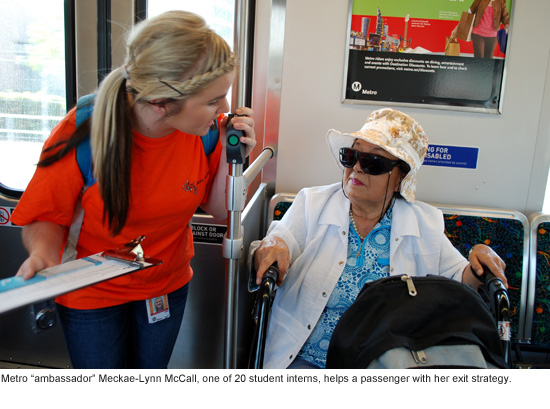 Meet Meckae-Lynn McCall, train ambassador.
Meet Meckae-Lynn McCall, train ambassador.
Although she’s just 20, and her ambassadorial appointment only lasts as long as her summer internship, she’s already got some diplomatic moves down.
There she was on an eastbound Gold Line train Thursday morning, brightly smiling as she complimented a bicyclist for stashing her ride in the correct area, and gently counseling an elderly traveler about where to exit (“The next station you’re going to want to get off…You’re very welcome, ma’am.”)
McCall is part of a new Metro summer program in which teams of student interns are jumping aboard trains and approaching customers at stations to spread the word that bikes—as well as wheelchairs, suitcases and other large items—now have a designated place on Metro trains.
Enforcers they’re not. Rather, the train ambassadors’ role is to “catch people being good,” said Alice Tolar, a Metro transportation planning manager who is overseeing the program.
“If I see you standing with your bike in the appropriate area, I’m going to thank you for that…We’re also letting non-cyclists hear what’s going on,” she said.
In addition to reinforcing good behavior, the interns will be handing out brochures detailing the agency’s current bike policy: big yellow decals now mark designated spaces on trains for bikes and other large items, and train cars are being reconfigured to create more space for bikes. (Only the Red Line cars are finished so far; reconfiguring the rest will take up to 18 months.)
The intern outreach program and the train car reconfiguration are elements of a broader effort by Metro to boost ridership by increasing its bicycle-friendliness. As part of those efforts, the agency has convened a Bicycle Roundtable and sponsored recently-released studies on how cyclists are using Metro Rail and the Orange Line. (A brief summary is here.)
The new student interns—20 of them in all—will start riding the rails officially on Monday, July 11. (Look for them first at the North Hollywood and Universal Red Line stations; they’ll be the ones in the bright orange T-shirts.) Meanwhile, they’ve divided up into teams: The Invincibles, The Phixies, Team Amazing and Team Enrique.
On Wednesday morning, they took part in some enthusiastic role-playing to get the feel of their various jobs, which in addition to train ambassador include platform ambassador, platform greeter and data collector.
With some help from the program leaders, the interns created and responded to characters ranging from an insistent smoker to a rider transporting unwieldy loads of flowers.
James Reed, who played the smoker as a blind man wielding a cardboard box as a cane, drew laughs in his mock showdown with another intern, Robert Jong. “Why can’t I smoke in the train? I’m handicapped!” he said, as Jong desperately cajoled, “Sir, there’s no smoking…”
(Afterward, they agreed that the interns shouldn’t try to confront people they see misbehaving but should notify security if it seems warranted.)
They also brainstormed ice-breakers for approaching customers, including “Nice bike!” or “We’ve made room for you” or the ever-popular, “Thank you for riding Metro!” The student interns are being paid from $8 to $12 an hour, depending on where they are in their education, from high school to grad school.
Their goal is “52 stations in 20 days”—not exactly “Around the World in 80 Days,” but definitely more do-able.
For some of the students, the internship is good experience for a future career in urban planning or transportation. For others, it’s a way to start—or expand—a professional resume. Either way, it’s a paying summer job, and a chance to encounter an unmatched array of people and situations on Metro trains.
One of the train ambassadors, Fayma Ishaq, a grad student at Cal Poly Pomona, struck up a conversation with lifelong transit rider Albert Herrera aboard the Gold Line Thursday. He told her he’d once seen a baby knocked to the ground by an impatient exiting passenger. “It’s good we’re making space because we don’t want incidents like this to happen,” Ishaq told Herrera.
Elsewhere on the train, Meckae-Lynn McCall, an early education major at Harding University, got a chance to hand out one of the first brochures to cyclist Marissa Siaz, a freelance cake decorator who also works in a Pasadena school supply store and a South Pasadena pizza place.
Siaz, 21, said she generally feels comfortable taking her bike onboard the train. “I feel welcome as long as I put it where it’s supposed to go,” she said. As for the new, intern-powered outreach campaign? Couldn’t hurt, she said. “I think most people already know [how and where to put their bike] and they just don’t want to do it. Some people don’t want to leave it there.”
Photos by Supervisor Yaroslavsky’s web staff
Posted 7/8/11
Out and about after the 405 reopens
July 13, 2011
Nothing like taking the 405 Freeway out of commission to put a crimp in L.A.’s weekend plans. But just because you’re being a good citizen and hunkering down during Carmageddon doesn’t mean you have to stay put once the weekend’s over. Here are some outings that are sure to cure your cabin fever once the work week begins.
UCLA Hammer Museum
Human rights activist John Prendergast speaks about his mentoring experiences in the Big Brothers program at the UCLA Hammer Museum on Tuesday, July 19, at 6 p.m. Prendergast recently wrote a book about how his 25-year relationship with his “little brother” transformed both of their lives. The free lecture is part of a series called “Zócalo at the Hammer,” which focuses on important social issues of our times. Tickets and details about the lecture are available on the website.
Also at the Hammer, up-and-coming writers read from their works as the culmination of their Emerging Voices literary fellowship. Hear what they have to say on Wednesday, July 20, at 6 p.m. Five writers will perform their final readings free of charge.
Hollywood Bowl
The hilarious, tangential ramblings of comedian Eddie Izzard take center stage this Wednesday, July 20, at the Hollywood Bowl. Izzard’s irreverent stand-up has earned him a place on Comedy Central’s 100 Greatest Standup Acts of All Time, and placed him in the top 20 in a 2005 poll of fellow comedians, “The Comedian’s Comedian.” The show starts at 8 p.m. Purchase your tickets on the Bowl’s website, where you’ll also find directions.
Skirball Cultural Center
The Skirball’s closed this weekend but you can make up for lost time next week when the sounds of Cape Verde ring through the cultural center. Singer Maria de Barros starts the 2011 “Sunset Concerts” series on the right note with her Thursday, July 21, performance. De Barros’s native Cape Verde is an archipelago nation in the Atlantic Ocean about 350 miles off the coast of West Africa. Her music combines the Latin, African and French influences of Cape Verdean music with Spanish, Caribbean, and Latin American sounds. Doors open at 7 p.m. and the free concert starts at 8 p.m. Find out more on the Skirball Center’s website.
The Getty Center
Like the Skirball, the Getty will be closed this weekend. So make it a point to get up there next week, when renowned architect and urban planner Julio César Pérez Hernández animates the architecture of past, present and future Cuba in the latest installment of the Getty’s lecture series. Pérez Hernández recently led a team of Cuban architects in the creation of a new master plan for Havana, and has written extensively within the field. His free lecture accompanies the exhibition “A Revolutionary Project: Cuba from Walker Evans to Now,” which documents Cuba in photos taken before, during and after the 1959 Revolution. It begins at 7 p.m. on Thursday, July 21. Reservations are recommended, and can be made online.
Posted 7/13/11
County re-ups with Homeboy
July 13, 2011
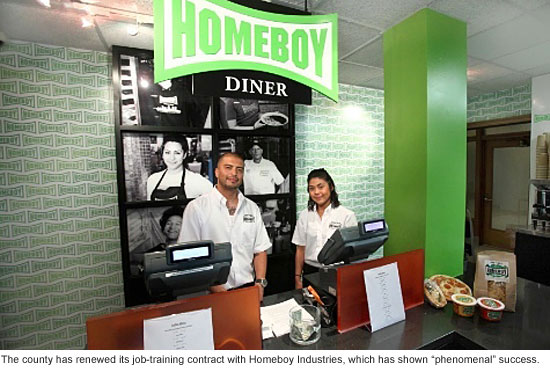 Nine months after Los Angeles County stepped in to help keep the doors open at Homeboy Industries, its contract for re-entry services has been extended, preserving a key source of job training for gang-affiliated probationers and parolees.
Nine months after Los Angeles County stepped in to help keep the doors open at Homeboy Industries, its contract for re-entry services has been extended, preserving a key source of job training for gang-affiliated probationers and parolees.
The Board of Supervisors on Tuesday voted to renew the county’s $1.3 million agreement with Homeboy, which originally had been approved as a 9-month pilot project.
The public money will pay for 12 more months of job training, tattoo removal, legal counseling and other services for more than 600 county probationers and parolees between the ages of 14 and 30. It also will continue to fund 20 to 30 revolving job trainee positions at Homeboy businesses, along with an ongoing outside evaluation of the program’s effectiveness.
Although the final evaluation of the joint venture’s first nine months won’t be complete until August, the social scientists conducting it say Homeboy’s success rate appears to be strikingly higher than the national average.
UCLA adjunct professor Jorja Leap said preliminary data shows approximately 80% of the county-funded trainees to be either fully employed or still enrolled in the Homeboy program at the end of the initial 9-month contract, with only about 10% back behind bars. The national rate of re-incarceration among gang members is about seven times higher than that, Leap says.
“This is all very cautionary and short term, and with the contract renewed, we’ll be able to learn even more,” she says. But if the numbers hold up, “it’s absolutely phenomenal.”
Founded in 1992 by the Rev. Greg Boyle, a Jesuit priest, Homeboy Industries is the nation’s largest gang intervention program. Operating under the slogan, “Nothing stops a bullet like a job,” the organization operates a bakery, two cafes, a silk screening and embroidery shop and a janitorial company, among other endeavors.
The organization also is known for its tattoo removal program—a prosaic but potentially life-altering service that annually eliminates a crucial job impediment for thousands of repentant gang members. Boyle has said Homeboy’s job training, educational, legal and mental health services help some 12,000 at-risk youths and young adults every year.
Boyle has noted that Homeboy has served for years as the county’s unofficial—and largely un-reimbursed—“after-care and re-entry program for gang members.” According to Leap’s preliminary numbers, Homeboy’s client base is overwhelmingly, if not entirely, made up of county probationers and parolees who came to Homeboy on their own initiative.
The county also runs various re-entry programs for ex-inmates, but the demand for help far outstrips the supply, says Cal Remington, chief deputy of the county’s Department of Probation. So when a financial shortfall last year forced the organization to lay off hundreds of staffers, Homeboy turned to the county as a natural ally.
“This is really a public safety issue for the county,” says Homeboy’s Chief Operating Officer Veronica Vargas. “You can’t expect someone who has never held a job to walk back into society and know how to get hired.”
Remington calls Homeboy “a good resource,” particularly in light of the state’s desire to shift responsibility to the county for thousands of non-violent parolees, who “still tend to need a lot of resources wrapped around them…Homeboy is legitimate, and has credibility in the community, so I think they could have a real role to play.”
Posted 6/28/11
Our Carmageddon cheat sheet
July 13, 2011
 After months of preparations and weeks of dire prognostications, the 53-hour closure of the 405 Freeway is finally upon us. Whether L.A. faces Carmageddon this weekend or witnesses a benign replay of the traffic-lite1984 Olympics, knowing a few basics will help you successfully navigate the shutdown.
After months of preparations and weeks of dire prognostications, the 53-hour closure of the 405 Freeway is finally upon us. Whether L.A. faces Carmageddon this weekend or witnesses a benign replay of the traffic-lite1984 Olympics, knowing a few basics will help you successfully navigate the shutdown.
Beyond adopting the official mantra of “plan ahead, stay home, avoid the area,” here’s a short list of things you really need to know.
What’s happening when
As part of the $1.034 billion project to add a 10-mile northbound carpool line and other improvements to the 405 Freeway, on-ramps to the 405 between the 10 and 101 will begin closing at 7 p.m. on Friday, July 15. Traffic lanes will start closing at 10 p.m. Friday, and the freeway is scheduled to shut down completely at midnight. It is scheduled to remain closed all of Saturday, July 16, and Sunday, July 17. The closure, needed to demolish the south side of the Mulholland Bridge over the freeway, is scheduled to wrap up by 5 a.m. on Monday, July 18, with the freeway reopening to traffic at 6 a.m. The project website has more information.
What’s closed
The northbound 405 Freeway will be closed from the 10 to the 101. The southbound 405 will be closed from the 101 to Getty Center Drive. Sepulveda Boulevard is designated for local access only, and officials are strongly urging non-residents to stay away (although IDs will not be checked to verify residency). Canyon roads are expected to be clogged and gridlock could seriously affect freeways across the region—not just those on the Westside and in the San Fernando Valley—so don’t travel unless you really need to. (Here are some tips for making the best of it close to home.) And please note—The Getty and the Skirball Cultural Center are both closed all weekend.
Check out the detour maps
Getting around will likely be a challenge, no matter where you are in the region. If you must drive, here are the official detour maps.
Who to call in an emergency
As always, dial 911. Officials of the “unified command” overseeing public safety during the closure considered establishing a special number for nearby residents to call but decided that the capabilities of the 911 system (which can trace dropped calls and record all communications) made it the best way to go. For more on the emergency response plans, read this.
What to know before heading to LAX
This webpage provides valuable information for anyone who needs to get to or from the airport. Allow plenty of time, and plan ahead.
How to contact the project hotline
The 405 project hotline, (213) 922-3665, will be monitored all weekend. This is not the number to call in an emergency, or for driving directions, but is a good way to bring other matters to the attention of the project’s community relations staff. If you’d prefer to e-mail, contact information is on the project website.
Staying on top of traffic conditions
For real time traffic conditions, check out Go511.
Keeping up with developments on Twitter and Facebook
Get up-to-the-minute updates on Twitter. (Search for #405Official.) The project website is here and its Facebook page is here.
How to get a free ride on public transportation
Many Metro trains and buses will be free throughout the weekend, and extra service is planned. Read all about it here.
From the Valley to the beach—by bus
Just because the freeway’s closed doesn’t mean the beach is out of reach. Travelers from the San Fernando Valley and Topanga Canyon can ride the Topanga Canyon Summer Beach Bus to Topanga, Will Rogers and Santa Monica state beaches both days this weekend. The cost is 50 cents each way, with seniors and the disabled paying a quarter. The pickup and drop-off times and locations are here. The Topanga beach bus is adding special Sunday service this weekend to help offset the effects of the 405 Freeway closure. (Summer beach service from some other parts of the county is being suspended for the weekend; check the Department of Public Works website before making plans.)
What’s exactly happening out there anyway?
This detailed explanation of the demolition plans, posted on Metro’s blog The Source, gives a good sense of what will be going on while the freeway is closed. And in this live chat last month, officials explained why the Mulholland Bridge’s design—a steep single span with no center column—makes the full weekend closure necessary for safety reasons.
When do we get to do this again?
Mark your calendar: in about 11 months or so, demolition of the north side of the Mulholland Bridge is set to take place— which means another long freeway closure coming in 2012.
Posted 7/13/11




